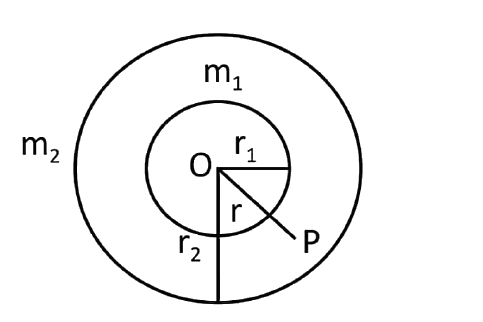If an experiment to determine the period of a simple pendulum of length 1m , it is attached to different spherical bobs of raddi r1 abd r2. The two spherical bobs have uniform mass distribution . If the relative difference in the periods mass distribution.. If the relative differene in the periods is found to be 5×10−4s, the difference in radii |r1−r2| is best given by
0.01cm
0.1cm
0.5cm
1cm
The correct Answer is:B
To solve the problem, we need to determine the difference in radii of two spherical bobs attached to a simple pendulum, given the relative difference in their periods.
1. Understand the Formula for the Period of a Simple Pendulum:
The period T of a simple pendulum is given by the formula:
T=2π√Lg
where L is the length of the pendulum and g is the acceleration due to gravity.
2. Identify the Length of the Pendulum:
The length L is measured from the point of suspension to the center of mass of the bob. For two bobs with radii r1 and r2:
- For the first bob, the effective length is L+r1.
- For the second bob, the effective length is L+r2.
3. Calculate the Periods for Both Bobs:
- The period for the first bob T1 is:
T1=2π√L+r1g
- The period for the second bob T2 is:
T2=2π√L+r2g
4. Find the Relative Difference in Periods:
The relative difference in periods is given as:
T1−T2T1=5×10−4T1
5. Use the Approximation for Small Differences:
For small differences, we can use the approximation:
T1−T2≈dTdL⋅(r1−r2)
where dT/dL can be derived from the period formula.
6. Differentiate the Period Formula:
Using the chain rule:
dTdL=ddL(2π√Lg)=π√gL
7. Relate the Differences in Lengths to the Radii:
The change in period can be expressed as:
T1−T2≈π√g(1√L+r1−1√L+r2)(r1−r2)
8. Substituting Values:
Given that L=1m and substituting the relative difference:
T1−T2T1=(r1−r2)2L
leads to:
5×10−4T1=|r1−r2|2
9. Calculate the Difference in Radii:
Rearranging gives:
|r1−r2|=2×5×10−4×T1
Since T1 is approximately 2π√1g (for g≈9.81m/s2):
T1≈2π√19.81≈2×3.14×0.32≈2.0s
Thus,
|r1−r2|≈2×5×10−4×2.0≈2×10−3m=0.002m=0.2cm
Final Answer:
The difference in radii |r1−r2| is approximately 0.2cm.
The period T of a simple pendulum is given by the formula:
T=2π√Lg
where L is the length of the pendulum and g is the acceleration due to gravity.
The length L is measured from the point of suspension to the center of mass of the bob. For two bobs with radii r1 and r2:
- For the first bob, the effective length is L+r1.
- For the second bob, the effective length is L+r2.
- The period for the first bob T1 is:
T1=2π√L+r1g
- The period for the second bob T2 is:
T2=2π√L+r2g
The relative difference in periods is given as:
T1−T2T1=5×10−4T1
For small differences, we can use the approximation:
T1−T2≈dTdL⋅(r1−r2)
where dT/dL can be derived from the period formula.
Using the chain rule:
dTdL=ddL(2π√Lg)=π√gL
The change in period can be expressed as:
T1−T2≈π√g(1√L+r1−1√L+r2)(r1−r2)
Given that L=1m and substituting the relative difference:
T1−T2T1=(r1−r2)2L
leads to:
5×10−4T1=|r1−r2|2
Rearranging gives:
|r1−r2|=2×5×10−4×T1
Since T1 is approximately 2π√1g (for g≈9.81m/s2):
T1≈2π√19.81≈2×3.14×0.32≈2.0s
Thus,
|r1−r2|≈2×5×10−4×2.0≈2×10−3m=0.002m=0.2cm
The difference in radii |r1−r2| is approximately 0.2cm.
Topper's Solved these Questions
- BOOK - MODERN PUBLICATIONCHAPTER - OSCILLATIONS EXERCISE - Competition File (JEE (Advanced) For IIT Entrance)7videos
OSCILLATIONS
- BOOK - MODERN PUBLICATIONCHAPTER - OSCILLATIONS EXERCISE - Competition File (Multiple choice question)11videos
OSCILLATIONS
- BOOK - MODERN PUBLICATIONCHAPTER - OSCILLATIONS EXERCISE - Competition File (Multiple choice questions) AIPMT/NEET other State Boards for Medical Entrance14videos
OSCILLATIONS
- BOOK - MODERN PUBLICATIONCHAPTER - MOTION IN A STRAIGHT LINE EXERCISE - CHAPTER PRACTICE TEST16videos
MOTION IN A STRAIGHT LINE
- BOOK - MODERN PUBLICATIONCHAPTER - PHYSICAL WORLD EXERCISE - Revision exercises (Long answer questions)6videos
PHYSICAL WORLD
Similar Questions
Consider two concentric spherical metal shells of radii r1 and r2(r2>r1). Find the charge on the inner shell and charge distribution.
View SolutionA compound pendulum consists of a rigid light rod having two spherical bobs of masses m1andm2 at distance l1andl2 from the centre of suspension. Find the time period of oscillations of the pendulum
View Solution
Knowledge Check
- Question 1 - Select One
In an experiment to determine the period of a simple pendulum of length 1 m, it is attached to different spherical bobs of radii r1 and r2. The two spherical bobs have uniform mass distribution. If the relative difference in the periods, is found to be 5×10−4 s, the difference in radii, |r1−r2| is best given by :
A1 cmB0.1 cmC0.5 cmD0.01 cm - Question 2 - Select One
If the inertial mass m1 of the bob of a simple pendulum of length 'l' is not equal to the gravitationalmassmg, then its period is
AT=2π√milmg.gBT=2π√mg.lmi.gCT=2π√lgDT=2π ⎷(mi+mg)(mi−mg).lg - Question 3 - Select One
Two spherical bodies have radii R,2R and emissivities e,2e If the temperature ratio is 2:1 then the powers will be in the ratio .
A1:1B2:1C3:1D4:1
Two concentric spherical shells of masses and radii m1,r1andm2,r2 respectively are as shown. The gravitational field intensity at point P is
 View Solution
View SolutionA simple pendulum of length 1 m with a bob of mass m swings with an angular amplitude 30∘. Then (g=9.8m/s2
View SolutionThe periodic time of a simple pendulum of length 1 m and amplitude 2 cm is 5 seconds. If the amplitude is made 4 cm , its periodic time in seconds will be
View SolutionTwo bodies of masses 8 kg and 4 kg are moving in concentric circular orbits of radii r1andr2 respectively . If their time periods are same , the ration of their centripetal accelerations is
View SolutionStatement-1 : Time period of a simple pendulum remains unchanged if solid bob is replaced by hollow bob of same radius but lesser mass.
Statement-2 Time period of a simple pendulum depends on the mass but does not depend on the density.View Solution

